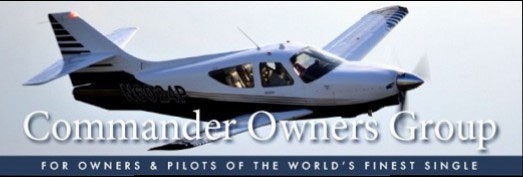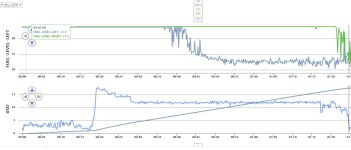Denver, CO
- Aircraft Year
- 1976
- Aircraft Type
- 114
- Reg Number
- N4742W
- Serial Number
- 14072
I had a great weekend. Got to the airport early Sunday morning, did my pre-flight, all is good, looked at fuel - decided I was good for the hour flight. Took off, great trip above a layer that broke up about 15 miles from my destination. This allowed me to pull throttle back and an easy decent below the broken layer, perfectly aligned with a left downwind into KTOR. Favorable wins and planning allowed for another amazing Commander landing.
Spent the day with friends and another one of my hobbies - then all too soon - it's time for me to go home. Go back to the airport, pre-flight 42W, breakout the ipad look at my intended flight - KTOR direct-ish (meander around a Bravo) to KFTG/KFCO - my home. Weather is good, light headwind. FBO has already closed for the day, look at fuel - it's an 1:12 flight, JPI says I have 1:47 of fuel - so I have the VFR reserve. I say, ok, I won't call out someone to get fuel and besides it is kinda expensive here. I bought the JPI so I would have more complete information for my decision making. It's below my minimums, but, I have good data, so clearly it's a good decision. So I depart.
Take off - all is great. I take off from 10, then turn south, climb up to 7500 - so for me a very low flight. Contact Denver, got Flight Following, feeling okay, but, nagging question about fuel. I look at the JPI, compare the data with the ipad and current location. Yes, the JPI says I will have 37 minutes of fuel above what I need. But, the gallons required from my ipad don't really match with the JPI and time available. I motor along, thinking - am I just being too cautious? My personal mins are typically an hour of reserve fuel. So is this discomfort because I am doing something different. I made the decision, I have good data. I keep flying.
It's been a whole 5 minutes now and when you are alone in the cockpit, with nothing but Approach/Center talking, you have some really good conversations with yourself. So those conversations circle around fuel, time, distance and COG posts. I remember someone posting about inaccurate fuel gauges. I recall a post about fuel flow and maneuvering. Then I have this epiphany. You decided to take off - ok - but - who says that means you can't change future decisions? Why not be flexible and review? The data on the ground was solid, but, now that you're 30 mins into it - it doesn't look as solid and it doesn't feel right. Why do you have to stick to the decision to go home? The decision was to depart - why not stop and take on some fuel? Who say's you can't do that? I talk to Denver, tell them I am swinging over to KCYS (Cheyenne) - they say thanks and hand me off to Cheyenne Approach who sets up up for an easy left downwind for 13. Simple nice pattern and Commander landing. I taxi over, top my tanks off and then head home.
I felt great going home - so I was 30-ish mins later than I thought - so what? I had another nice landing. I got a night landing. So with all these positives, why was it so hard to alter my VFR flight? Looking back, do I need to get "tougher" or relax my minimums? The answer is no. I am not a high time pilot only about 500 hours. I like safety and I feel better knowing that I am not painted into a corner. So I don't have to let decision bias drive future decisions.
So what is the "right" thing - that depends on you - but - in this instance - stopping for fuel was absolutely the right thing. Yes, I burned more fuel in diverting 15 miles, taxiing, and another departure. Looking at the math afterwards, I burned 1.2 gallons more than I had available (when I made the decision to divert) - even though the time till "empty" still had enough fuel and a 37 min reserve.
My lesson: Make the best decision you can with data available at the time, but don't make that a "until death do us part" decision. Be will to reevaluate, review and modify future decisions based on newer data and your degree of comfort. Don't let one decision dictate all the following decisions. Remain flexible, willing to reevaluate and modify your course,
Spent the day with friends and another one of my hobbies - then all too soon - it's time for me to go home. Go back to the airport, pre-flight 42W, breakout the ipad look at my intended flight - KTOR direct-ish (meander around a Bravo) to KFTG/KFCO - my home. Weather is good, light headwind. FBO has already closed for the day, look at fuel - it's an 1:12 flight, JPI says I have 1:47 of fuel - so I have the VFR reserve. I say, ok, I won't call out someone to get fuel and besides it is kinda expensive here. I bought the JPI so I would have more complete information for my decision making. It's below my minimums, but, I have good data, so clearly it's a good decision. So I depart.
Take off - all is great. I take off from 10, then turn south, climb up to 7500 - so for me a very low flight. Contact Denver, got Flight Following, feeling okay, but, nagging question about fuel. I look at the JPI, compare the data with the ipad and current location. Yes, the JPI says I will have 37 minutes of fuel above what I need. But, the gallons required from my ipad don't really match with the JPI and time available. I motor along, thinking - am I just being too cautious? My personal mins are typically an hour of reserve fuel. So is this discomfort because I am doing something different. I made the decision, I have good data. I keep flying.
It's been a whole 5 minutes now and when you are alone in the cockpit, with nothing but Approach/Center talking, you have some really good conversations with yourself. So those conversations circle around fuel, time, distance and COG posts. I remember someone posting about inaccurate fuel gauges. I recall a post about fuel flow and maneuvering. Then I have this epiphany. You decided to take off - ok - but - who says that means you can't change future decisions? Why not be flexible and review? The data on the ground was solid, but, now that you're 30 mins into it - it doesn't look as solid and it doesn't feel right. Why do you have to stick to the decision to go home? The decision was to depart - why not stop and take on some fuel? Who say's you can't do that? I talk to Denver, tell them I am swinging over to KCYS (Cheyenne) - they say thanks and hand me off to Cheyenne Approach who sets up up for an easy left downwind for 13. Simple nice pattern and Commander landing. I taxi over, top my tanks off and then head home.
I felt great going home - so I was 30-ish mins later than I thought - so what? I had another nice landing. I got a night landing. So with all these positives, why was it so hard to alter my VFR flight? Looking back, do I need to get "tougher" or relax my minimums? The answer is no. I am not a high time pilot only about 500 hours. I like safety and I feel better knowing that I am not painted into a corner. So I don't have to let decision bias drive future decisions.
So what is the "right" thing - that depends on you - but - in this instance - stopping for fuel was absolutely the right thing. Yes, I burned more fuel in diverting 15 miles, taxiing, and another departure. Looking at the math afterwards, I burned 1.2 gallons more than I had available (when I made the decision to divert) - even though the time till "empty" still had enough fuel and a 37 min reserve.
My lesson: Make the best decision you can with data available at the time, but don't make that a "until death do us part" decision. Be will to reevaluate, review and modify future decisions based on newer data and your degree of comfort. Don't let one decision dictate all the following decisions. Remain flexible, willing to reevaluate and modify your course,

